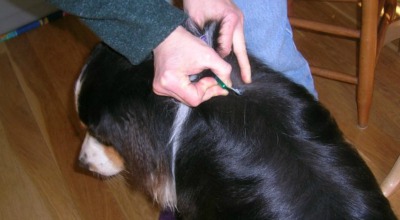Summer has officially arrived and the Oregon Department of Agriculture is offering advice to pet owners who can take several steps themselves in providing relief from fleas. An array of pesticide products on the market are among the tools that can be used to effectively control fleas, but they come with the usual caution of needing to be handled properly.
If occasional high temperatures this spring are any indication, summer might be blazing hot, which often exacerbates the skin irritation of pets that comes with flea bites. If that happens, pet owners will need to be ready for action. The first order of business is to verify the issue.
“Make sure your pet has a flea problem,” says Rose Kachadoorian, entomologist with the Oregon Department of Agriculture’s Pesticides Program. “They may be scratching themselves, but it could be a food allergy or pollen. Work with your veterinarian to establish whether the problem is caused by fleas.”

PHOTO COURTESY OF ODA
“I would vacuum my house at least every other day, if not every day, to suck up fleas and their eggs,” says Kachadoorian. “Also wash the pet’s bedding once a week with hot, soapy water.”
The most fastidious cleaning job in the world might not be enough if your pet already has fleas. Persistence in cleaning and early treatment is the key.
There are a number of adult flea control products available on the market, including spot-on topical products that are usually applied monthly. Some of the spot-on products also contain growth regulators that inhibit the development of immature flea life stages. Pets can also be given tablets orally containing these insect growth regulators. Flea collars and ultrasonic devices have had limited success, according to Kachadoorian. Again, a conversation with your veterinarian is an important step to take.
“Most of these products usually work very well,” says Kachadoorian. “They are so much more effective than the old days of putting a dust or spray on the animal or giving them a flea bath.”
Remember– most of these products are considered to be pesticides. Care and caution is required to use these flea control products because, if used incorrectly, the pet could have a bad reaction.
“You need to read that pesticide label very carefully and make sure you apply the product properly as instructed by the label,” says Kachadoorian. “The label instructions are not part of some marketing gimmick, but are there to protect animals and ensure that fleas are safely killed.”
For example, a product’s label may say that it is to be used only on dogs. Some active ingredients in products are not toxic to dogs but may be lethal to cats; an example would be permethrin.
Product labels also provide instructions on the appropriate age and weight of the animal being treated.
If your pet experiences a bad reaction from a spot-on product, immediately bathe the pet with mild soap, rinse with large amounts of water, and call your veterinarian. Ask your vet to report the reaction through the National Pesticide Information Center’s Veterinary Pesticide Incident Reporting Portal at









